PO630 Politics of the Middle East: Rentier State Essay Analysis
VerifiedAdded on 2022/10/08
|14
|3929
|16
Essay
AI Summary
This essay delves into the concept of the Rentier State in the Middle East, examining its historical context and impact on regional politics. The essay explores the rise and fall of the Ottoman Empire, the Arab-Israeli conflict, and the emergence of Palestinian refugees. It analyzes Arab nationalism, the rise of Islamic radicalism, and the role of external actors such as the United States, the European Union, and Russia. The essay also discusses the Rentier State theory, its core arguments, and critiques, highlighting the relationship between resource wealth, state revenue, and political dynamics. The essay provides a comprehensive overview of the complex interplay of factors shaping the Middle East, from historical conflicts to ideological developments and the influence of external powers, concluding with the imperial legacy of the United States and its consequences on the Arab countries of this region.
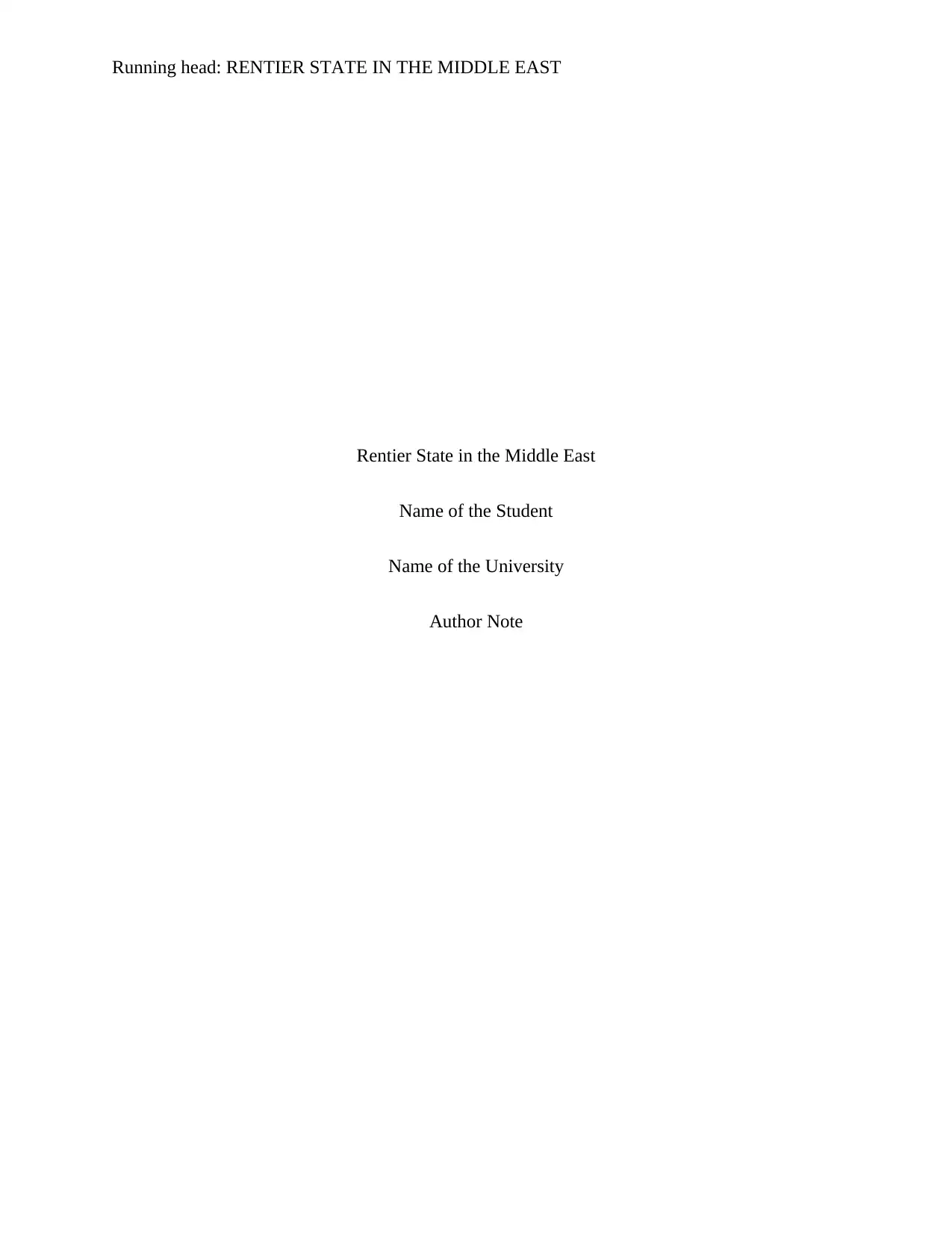
Running head: RENTIER STATE IN THE MIDDLE EAST
Rentier State in the Middle East
Name of the Student
Name of the University
Author Note
Rentier State in the Middle East
Name of the Student
Name of the University
Author Note
Paraphrase This Document
Need a fresh take? Get an instant paraphrase of this document with our AI Paraphraser
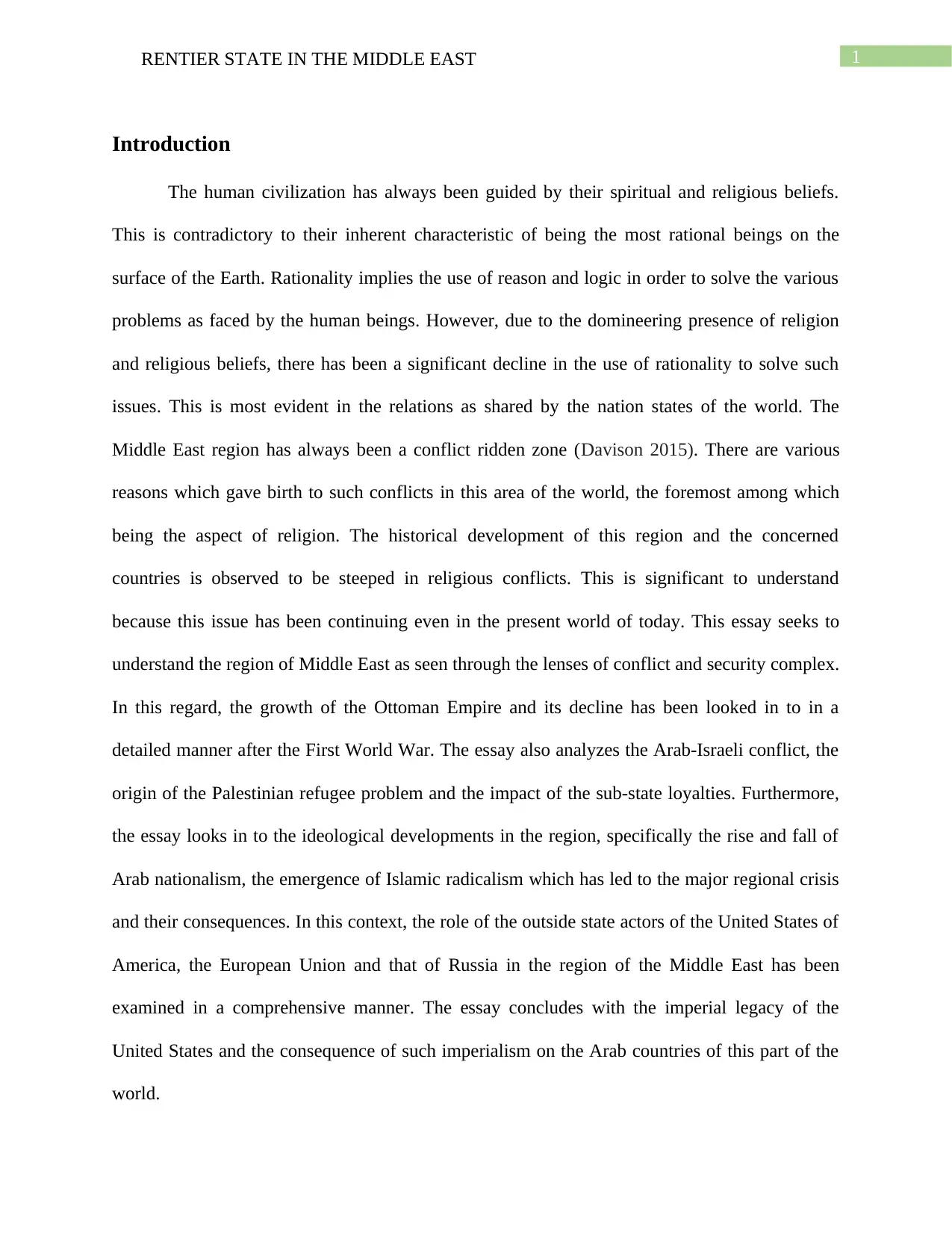
1RENTIER STATE IN THE MIDDLE EAST
Introduction
The human civilization has always been guided by their spiritual and religious beliefs.
This is contradictory to their inherent characteristic of being the most rational beings on the
surface of the Earth. Rationality implies the use of reason and logic in order to solve the various
problems as faced by the human beings. However, due to the domineering presence of religion
and religious beliefs, there has been a significant decline in the use of rationality to solve such
issues. This is most evident in the relations as shared by the nation states of the world. The
Middle East region has always been a conflict ridden zone (Davison 2015). There are various
reasons which gave birth to such conflicts in this area of the world, the foremost among which
being the aspect of religion. The historical development of this region and the concerned
countries is observed to be steeped in religious conflicts. This is significant to understand
because this issue has been continuing even in the present world of today. This essay seeks to
understand the region of Middle East as seen through the lenses of conflict and security complex.
In this regard, the growth of the Ottoman Empire and its decline has been looked in to in a
detailed manner after the First World War. The essay also analyzes the Arab-Israeli conflict, the
origin of the Palestinian refugee problem and the impact of the sub-state loyalties. Furthermore,
the essay looks in to the ideological developments in the region, specifically the rise and fall of
Arab nationalism, the emergence of Islamic radicalism which has led to the major regional crisis
and their consequences. In this context, the role of the outside state actors of the United States of
America, the European Union and that of Russia in the region of the Middle East has been
examined in a comprehensive manner. The essay concludes with the imperial legacy of the
United States and the consequence of such imperialism on the Arab countries of this part of the
world.
Introduction
The human civilization has always been guided by their spiritual and religious beliefs.
This is contradictory to their inherent characteristic of being the most rational beings on the
surface of the Earth. Rationality implies the use of reason and logic in order to solve the various
problems as faced by the human beings. However, due to the domineering presence of religion
and religious beliefs, there has been a significant decline in the use of rationality to solve such
issues. This is most evident in the relations as shared by the nation states of the world. The
Middle East region has always been a conflict ridden zone (Davison 2015). There are various
reasons which gave birth to such conflicts in this area of the world, the foremost among which
being the aspect of religion. The historical development of this region and the concerned
countries is observed to be steeped in religious conflicts. This is significant to understand
because this issue has been continuing even in the present world of today. This essay seeks to
understand the region of Middle East as seen through the lenses of conflict and security complex.
In this regard, the growth of the Ottoman Empire and its decline has been looked in to in a
detailed manner after the First World War. The essay also analyzes the Arab-Israeli conflict, the
origin of the Palestinian refugee problem and the impact of the sub-state loyalties. Furthermore,
the essay looks in to the ideological developments in the region, specifically the rise and fall of
Arab nationalism, the emergence of Islamic radicalism which has led to the major regional crisis
and their consequences. In this context, the role of the outside state actors of the United States of
America, the European Union and that of Russia in the region of the Middle East has been
examined in a comprehensive manner. The essay concludes with the imperial legacy of the
United States and the consequence of such imperialism on the Arab countries of this part of the
world.
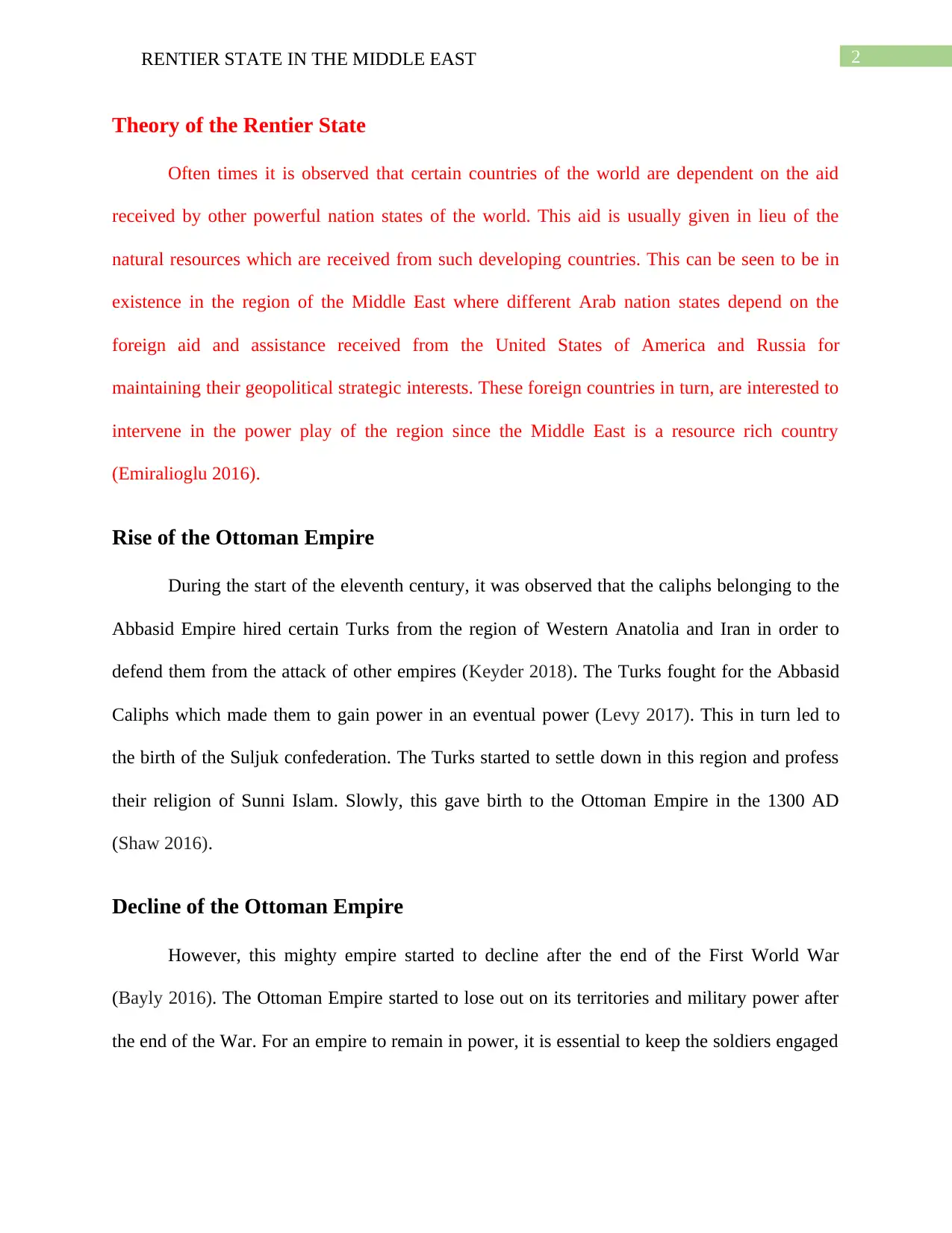
2RENTIER STATE IN THE MIDDLE EAST
Theory of the Rentier State
Often times it is observed that certain countries of the world are dependent on the aid
received by other powerful nation states of the world. This aid is usually given in lieu of the
natural resources which are received from such developing countries. This can be seen to be in
existence in the region of the Middle East where different Arab nation states depend on the
foreign aid and assistance received from the United States of America and Russia for
maintaining their geopolitical strategic interests. These foreign countries in turn, are interested to
intervene in the power play of the region since the Middle East is a resource rich country
(Emiralioglu 2016).
Rise of the Ottoman Empire
During the start of the eleventh century, it was observed that the caliphs belonging to the
Abbasid Empire hired certain Turks from the region of Western Anatolia and Iran in order to
defend them from the attack of other empires (Keyder 2018). The Turks fought for the Abbasid
Caliphs which made them to gain power in an eventual power (Levy 2017). This in turn led to
the birth of the Suljuk confederation. The Turks started to settle down in this region and profess
their religion of Sunni Islam. Slowly, this gave birth to the Ottoman Empire in the 1300 AD
(Shaw 2016).
Decline of the Ottoman Empire
However, this mighty empire started to decline after the end of the First World War
(Bayly 2016). The Ottoman Empire started to lose out on its territories and military power after
the end of the War. For an empire to remain in power, it is essential to keep the soldiers engaged
Theory of the Rentier State
Often times it is observed that certain countries of the world are dependent on the aid
received by other powerful nation states of the world. This aid is usually given in lieu of the
natural resources which are received from such developing countries. This can be seen to be in
existence in the region of the Middle East where different Arab nation states depend on the
foreign aid and assistance received from the United States of America and Russia for
maintaining their geopolitical strategic interests. These foreign countries in turn, are interested to
intervene in the power play of the region since the Middle East is a resource rich country
(Emiralioglu 2016).
Rise of the Ottoman Empire
During the start of the eleventh century, it was observed that the caliphs belonging to the
Abbasid Empire hired certain Turks from the region of Western Anatolia and Iran in order to
defend them from the attack of other empires (Keyder 2018). The Turks fought for the Abbasid
Caliphs which made them to gain power in an eventual power (Levy 2017). This in turn led to
the birth of the Suljuk confederation. The Turks started to settle down in this region and profess
their religion of Sunni Islam. Slowly, this gave birth to the Ottoman Empire in the 1300 AD
(Shaw 2016).
Decline of the Ottoman Empire
However, this mighty empire started to decline after the end of the First World War
(Bayly 2016). The Ottoman Empire started to lose out on its territories and military power after
the end of the War. For an empire to remain in power, it is essential to keep the soldiers engaged
⊘ This is a preview!⊘
Do you want full access?
Subscribe today to unlock all pages.

Trusted by 1+ million students worldwide
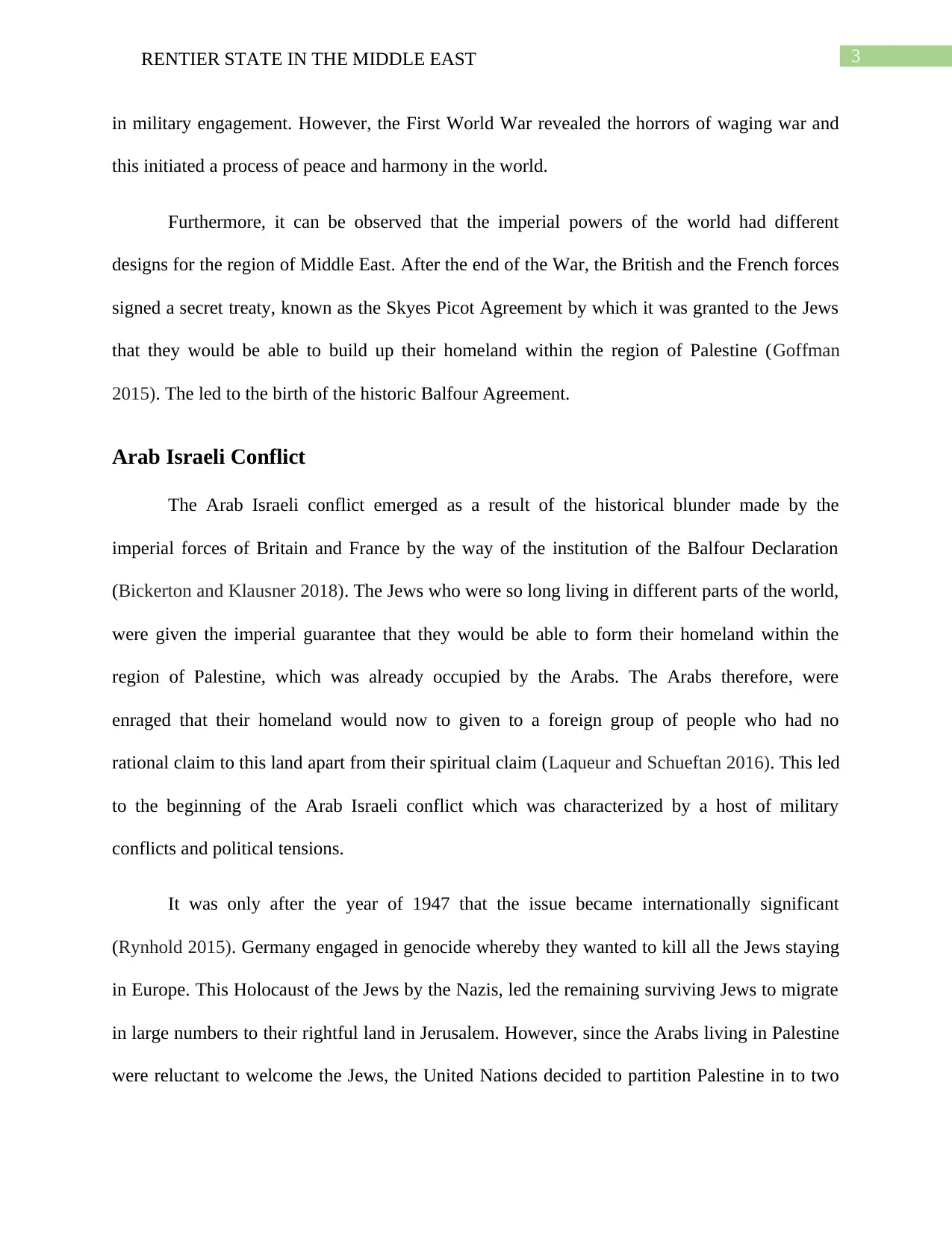
3RENTIER STATE IN THE MIDDLE EAST
in military engagement. However, the First World War revealed the horrors of waging war and
this initiated a process of peace and harmony in the world.
Furthermore, it can be observed that the imperial powers of the world had different
designs for the region of Middle East. After the end of the War, the British and the French forces
signed a secret treaty, known as the Skyes Picot Agreement by which it was granted to the Jews
that they would be able to build up their homeland within the region of Palestine (Goffman
2015). The led to the birth of the historic Balfour Agreement.
Arab Israeli Conflict
The Arab Israeli conflict emerged as a result of the historical blunder made by the
imperial forces of Britain and France by the way of the institution of the Balfour Declaration
(Bickerton and Klausner 2018). The Jews who were so long living in different parts of the world,
were given the imperial guarantee that they would be able to form their homeland within the
region of Palestine, which was already occupied by the Arabs. The Arabs therefore, were
enraged that their homeland would now to given to a foreign group of people who had no
rational claim to this land apart from their spiritual claim (Laqueur and Schueftan 2016). This led
to the beginning of the Arab Israeli conflict which was characterized by a host of military
conflicts and political tensions.
It was only after the year of 1947 that the issue became internationally significant
(Rynhold 2015). Germany engaged in genocide whereby they wanted to kill all the Jews staying
in Europe. This Holocaust of the Jews by the Nazis, led the remaining surviving Jews to migrate
in large numbers to their rightful land in Jerusalem. However, since the Arabs living in Palestine
were reluctant to welcome the Jews, the United Nations decided to partition Palestine in to two
in military engagement. However, the First World War revealed the horrors of waging war and
this initiated a process of peace and harmony in the world.
Furthermore, it can be observed that the imperial powers of the world had different
designs for the region of Middle East. After the end of the War, the British and the French forces
signed a secret treaty, known as the Skyes Picot Agreement by which it was granted to the Jews
that they would be able to build up their homeland within the region of Palestine (Goffman
2015). The led to the birth of the historic Balfour Agreement.
Arab Israeli Conflict
The Arab Israeli conflict emerged as a result of the historical blunder made by the
imperial forces of Britain and France by the way of the institution of the Balfour Declaration
(Bickerton and Klausner 2018). The Jews who were so long living in different parts of the world,
were given the imperial guarantee that they would be able to form their homeland within the
region of Palestine, which was already occupied by the Arabs. The Arabs therefore, were
enraged that their homeland would now to given to a foreign group of people who had no
rational claim to this land apart from their spiritual claim (Laqueur and Schueftan 2016). This led
to the beginning of the Arab Israeli conflict which was characterized by a host of military
conflicts and political tensions.
It was only after the year of 1947 that the issue became internationally significant
(Rynhold 2015). Germany engaged in genocide whereby they wanted to kill all the Jews staying
in Europe. This Holocaust of the Jews by the Nazis, led the remaining surviving Jews to migrate
in large numbers to their rightful land in Jerusalem. However, since the Arabs living in Palestine
were reluctant to welcome the Jews, the United Nations decided to partition Palestine in to two
Paraphrase This Document
Need a fresh take? Get an instant paraphrase of this document with our AI Paraphraser
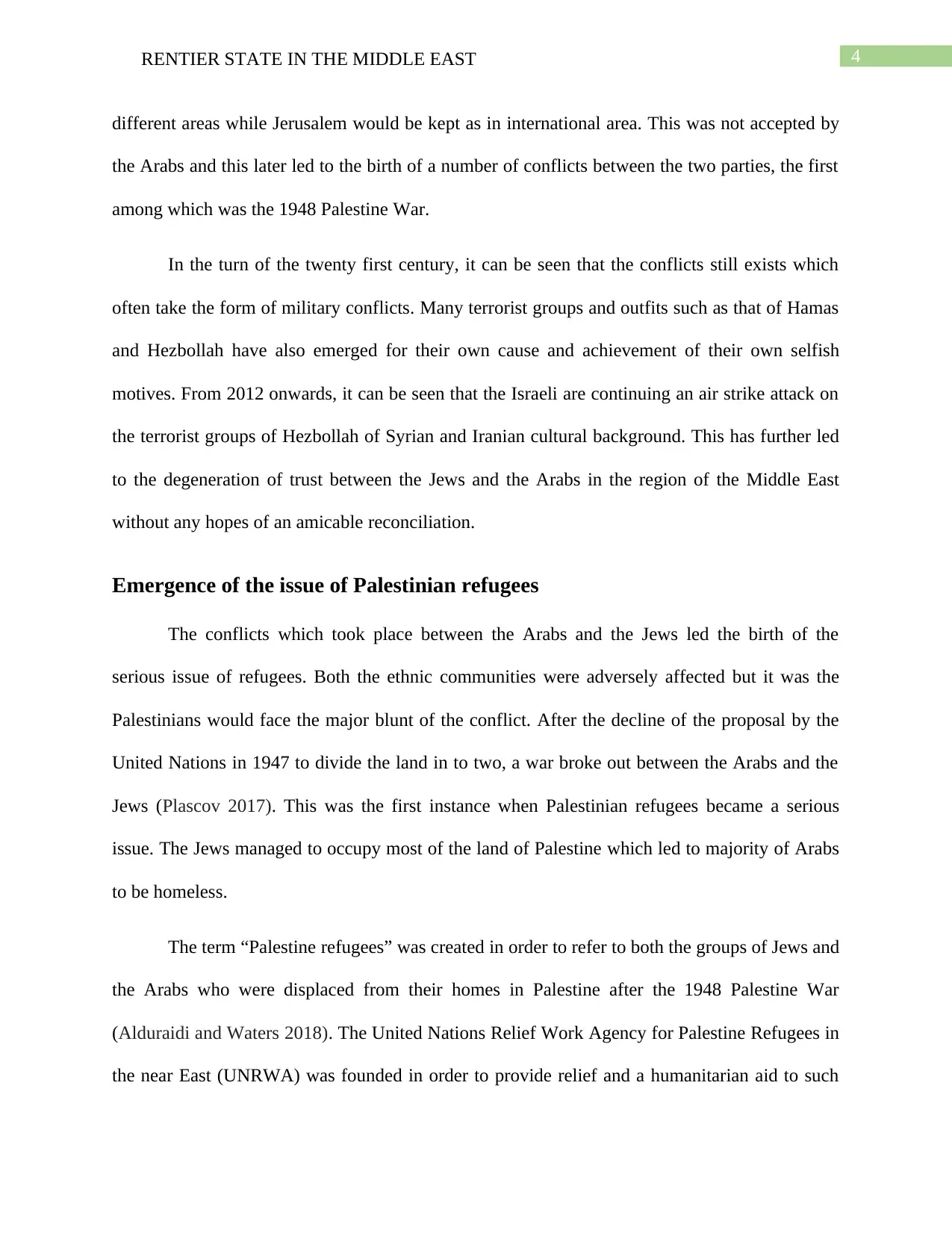
4RENTIER STATE IN THE MIDDLE EAST
different areas while Jerusalem would be kept as in international area. This was not accepted by
the Arabs and this later led to the birth of a number of conflicts between the two parties, the first
among which was the 1948 Palestine War.
In the turn of the twenty first century, it can be seen that the conflicts still exists which
often take the form of military conflicts. Many terrorist groups and outfits such as that of Hamas
and Hezbollah have also emerged for their own cause and achievement of their own selfish
motives. From 2012 onwards, it can be seen that the Israeli are continuing an air strike attack on
the terrorist groups of Hezbollah of Syrian and Iranian cultural background. This has further led
to the degeneration of trust between the Jews and the Arabs in the region of the Middle East
without any hopes of an amicable reconciliation.
Emergence of the issue of Palestinian refugees
The conflicts which took place between the Arabs and the Jews led the birth of the
serious issue of refugees. Both the ethnic communities were adversely affected but it was the
Palestinians would face the major blunt of the conflict. After the decline of the proposal by the
United Nations in 1947 to divide the land in to two, a war broke out between the Arabs and the
Jews (Plascov 2017). This was the first instance when Palestinian refugees became a serious
issue. The Jews managed to occupy most of the land of Palestine which led to majority of Arabs
to be homeless.
The term “Palestine refugees” was created in order to refer to both the groups of Jews and
the Arabs who were displaced from their homes in Palestine after the 1948 Palestine War
(Alduraidi and Waters 2018). The United Nations Relief Work Agency for Palestine Refugees in
the near East (UNRWA) was founded in order to provide relief and a humanitarian aid to such
different areas while Jerusalem would be kept as in international area. This was not accepted by
the Arabs and this later led to the birth of a number of conflicts between the two parties, the first
among which was the 1948 Palestine War.
In the turn of the twenty first century, it can be seen that the conflicts still exists which
often take the form of military conflicts. Many terrorist groups and outfits such as that of Hamas
and Hezbollah have also emerged for their own cause and achievement of their own selfish
motives. From 2012 onwards, it can be seen that the Israeli are continuing an air strike attack on
the terrorist groups of Hezbollah of Syrian and Iranian cultural background. This has further led
to the degeneration of trust between the Jews and the Arabs in the region of the Middle East
without any hopes of an amicable reconciliation.
Emergence of the issue of Palestinian refugees
The conflicts which took place between the Arabs and the Jews led the birth of the
serious issue of refugees. Both the ethnic communities were adversely affected but it was the
Palestinians would face the major blunt of the conflict. After the decline of the proposal by the
United Nations in 1947 to divide the land in to two, a war broke out between the Arabs and the
Jews (Plascov 2017). This was the first instance when Palestinian refugees became a serious
issue. The Jews managed to occupy most of the land of Palestine which led to majority of Arabs
to be homeless.
The term “Palestine refugees” was created in order to refer to both the groups of Jews and
the Arabs who were displaced from their homes in Palestine after the 1948 Palestine War
(Alduraidi and Waters 2018). The United Nations Relief Work Agency for Palestine Refugees in
the near East (UNRWA) was founded in order to provide relief and a humanitarian aid to such
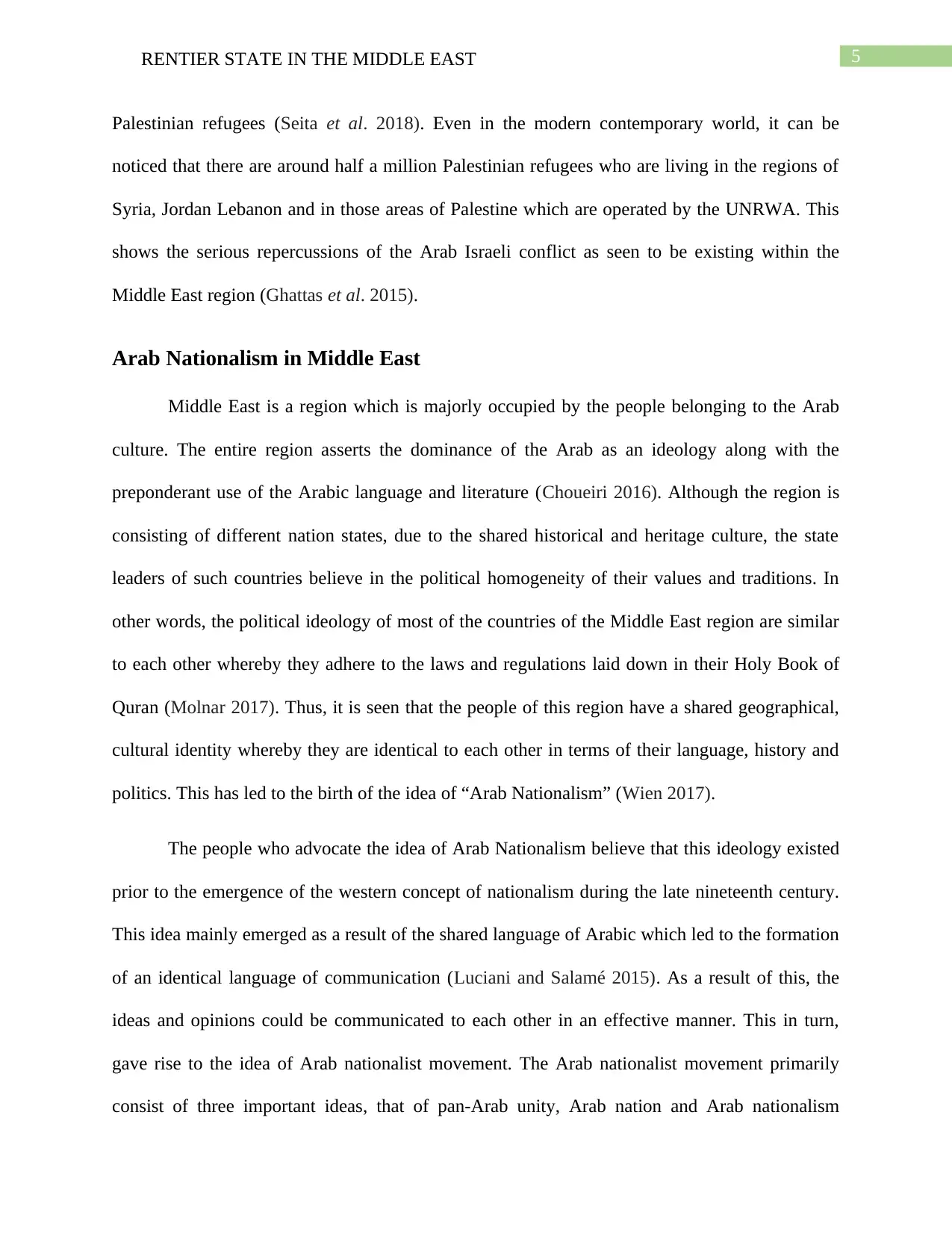
5RENTIER STATE IN THE MIDDLE EAST
Palestinian refugees (Seita et al. 2018). Even in the modern contemporary world, it can be
noticed that there are around half a million Palestinian refugees who are living in the regions of
Syria, Jordan Lebanon and in those areas of Palestine which are operated by the UNRWA. This
shows the serious repercussions of the Arab Israeli conflict as seen to be existing within the
Middle East region (Ghattas et al. 2015).
Arab Nationalism in Middle East
Middle East is a region which is majorly occupied by the people belonging to the Arab
culture. The entire region asserts the dominance of the Arab as an ideology along with the
preponderant use of the Arabic language and literature (Choueiri 2016). Although the region is
consisting of different nation states, due to the shared historical and heritage culture, the state
leaders of such countries believe in the political homogeneity of their values and traditions. In
other words, the political ideology of most of the countries of the Middle East region are similar
to each other whereby they adhere to the laws and regulations laid down in their Holy Book of
Quran (Molnar 2017). Thus, it is seen that the people of this region have a shared geographical,
cultural identity whereby they are identical to each other in terms of their language, history and
politics. This has led to the birth of the idea of “Arab Nationalism” (Wien 2017).
The people who advocate the idea of Arab Nationalism believe that this ideology existed
prior to the emergence of the western concept of nationalism during the late nineteenth century.
This idea mainly emerged as a result of the shared language of Arabic which led to the formation
of an identical language of communication (Luciani and Salamé 2015). As a result of this, the
ideas and opinions could be communicated to each other in an effective manner. This in turn,
gave rise to the idea of Arab nationalist movement. The Arab nationalist movement primarily
consist of three important ideas, that of pan-Arab unity, Arab nation and Arab nationalism
Palestinian refugees (Seita et al. 2018). Even in the modern contemporary world, it can be
noticed that there are around half a million Palestinian refugees who are living in the regions of
Syria, Jordan Lebanon and in those areas of Palestine which are operated by the UNRWA. This
shows the serious repercussions of the Arab Israeli conflict as seen to be existing within the
Middle East region (Ghattas et al. 2015).
Arab Nationalism in Middle East
Middle East is a region which is majorly occupied by the people belonging to the Arab
culture. The entire region asserts the dominance of the Arab as an ideology along with the
preponderant use of the Arabic language and literature (Choueiri 2016). Although the region is
consisting of different nation states, due to the shared historical and heritage culture, the state
leaders of such countries believe in the political homogeneity of their values and traditions. In
other words, the political ideology of most of the countries of the Middle East region are similar
to each other whereby they adhere to the laws and regulations laid down in their Holy Book of
Quran (Molnar 2017). Thus, it is seen that the people of this region have a shared geographical,
cultural identity whereby they are identical to each other in terms of their language, history and
politics. This has led to the birth of the idea of “Arab Nationalism” (Wien 2017).
The people who advocate the idea of Arab Nationalism believe that this ideology existed
prior to the emergence of the western concept of nationalism during the late nineteenth century.
This idea mainly emerged as a result of the shared language of Arabic which led to the formation
of an identical language of communication (Luciani and Salamé 2015). As a result of this, the
ideas and opinions could be communicated to each other in an effective manner. This in turn,
gave rise to the idea of Arab nationalist movement. The Arab nationalist movement primarily
consist of three important ideas, that of pan-Arab unity, Arab nation and Arab nationalism
⊘ This is a preview!⊘
Do you want full access?
Subscribe today to unlock all pages.

Trusted by 1+ million students worldwide
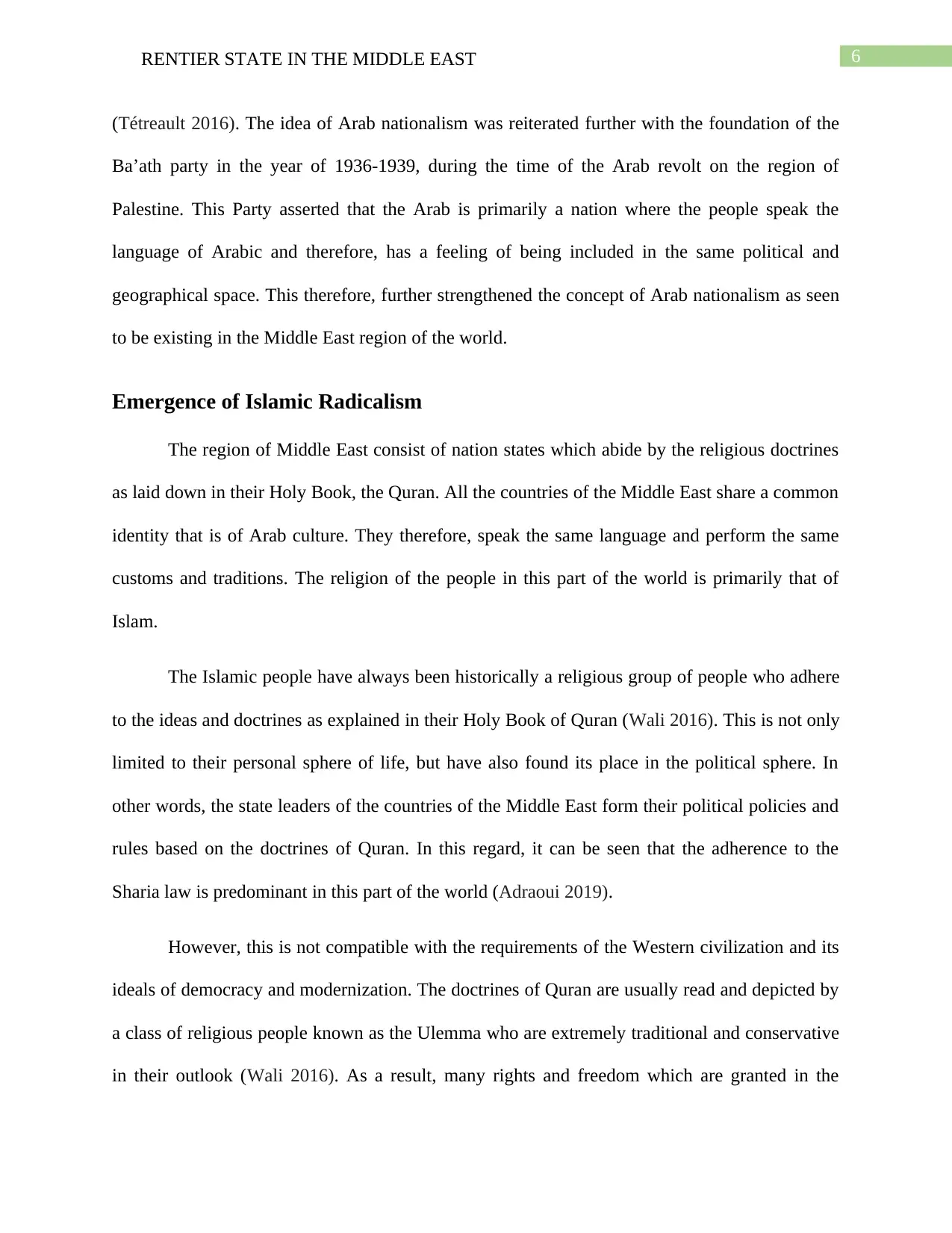
6RENTIER STATE IN THE MIDDLE EAST
(Tétreault 2016). The idea of Arab nationalism was reiterated further with the foundation of the
Ba’ath party in the year of 1936-1939, during the time of the Arab revolt on the region of
Palestine. This Party asserted that the Arab is primarily a nation where the people speak the
language of Arabic and therefore, has a feeling of being included in the same political and
geographical space. This therefore, further strengthened the concept of Arab nationalism as seen
to be existing in the Middle East region of the world.
Emergence of Islamic Radicalism
The region of Middle East consist of nation states which abide by the religious doctrines
as laid down in their Holy Book, the Quran. All the countries of the Middle East share a common
identity that is of Arab culture. They therefore, speak the same language and perform the same
customs and traditions. The religion of the people in this part of the world is primarily that of
Islam.
The Islamic people have always been historically a religious group of people who adhere
to the ideas and doctrines as explained in their Holy Book of Quran (Wali 2016). This is not only
limited to their personal sphere of life, but have also found its place in the political sphere. In
other words, the state leaders of the countries of the Middle East form their political policies and
rules based on the doctrines of Quran. In this regard, it can be seen that the adherence to the
Sharia law is predominant in this part of the world (Adraoui 2019).
However, this is not compatible with the requirements of the Western civilization and its
ideals of democracy and modernization. The doctrines of Quran are usually read and depicted by
a class of religious people known as the Ulemma who are extremely traditional and conservative
in their outlook (Wali 2016). As a result, many rights and freedom which are granted in the
(Tétreault 2016). The idea of Arab nationalism was reiterated further with the foundation of the
Ba’ath party in the year of 1936-1939, during the time of the Arab revolt on the region of
Palestine. This Party asserted that the Arab is primarily a nation where the people speak the
language of Arabic and therefore, has a feeling of being included in the same political and
geographical space. This therefore, further strengthened the concept of Arab nationalism as seen
to be existing in the Middle East region of the world.
Emergence of Islamic Radicalism
The region of Middle East consist of nation states which abide by the religious doctrines
as laid down in their Holy Book, the Quran. All the countries of the Middle East share a common
identity that is of Arab culture. They therefore, speak the same language and perform the same
customs and traditions. The religion of the people in this part of the world is primarily that of
Islam.
The Islamic people have always been historically a religious group of people who adhere
to the ideas and doctrines as explained in their Holy Book of Quran (Wali 2016). This is not only
limited to their personal sphere of life, but have also found its place in the political sphere. In
other words, the state leaders of the countries of the Middle East form their political policies and
rules based on the doctrines of Quran. In this regard, it can be seen that the adherence to the
Sharia law is predominant in this part of the world (Adraoui 2019).
However, this is not compatible with the requirements of the Western civilization and its
ideals of democracy and modernization. The doctrines of Quran are usually read and depicted by
a class of religious people known as the Ulemma who are extremely traditional and conservative
in their outlook (Wali 2016). As a result, many rights and freedom which are granted in the
Paraphrase This Document
Need a fresh take? Get an instant paraphrase of this document with our AI Paraphraser
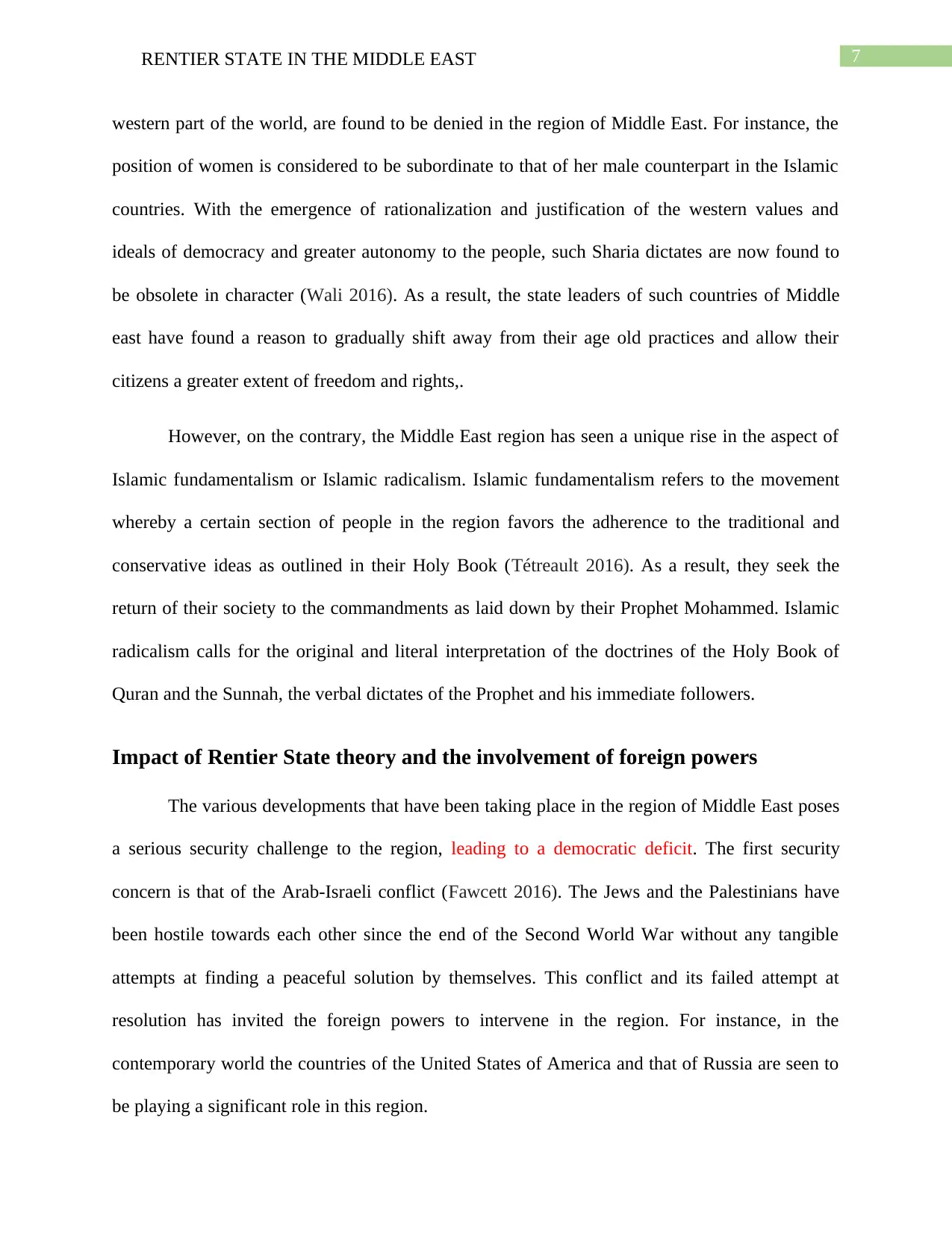
7RENTIER STATE IN THE MIDDLE EAST
western part of the world, are found to be denied in the region of Middle East. For instance, the
position of women is considered to be subordinate to that of her male counterpart in the Islamic
countries. With the emergence of rationalization and justification of the western values and
ideals of democracy and greater autonomy to the people, such Sharia dictates are now found to
be obsolete in character (Wali 2016). As a result, the state leaders of such countries of Middle
east have found a reason to gradually shift away from their age old practices and allow their
citizens a greater extent of freedom and rights,.
However, on the contrary, the Middle East region has seen a unique rise in the aspect of
Islamic fundamentalism or Islamic radicalism. Islamic fundamentalism refers to the movement
whereby a certain section of people in the region favors the adherence to the traditional and
conservative ideas as outlined in their Holy Book (Tétreault 2016). As a result, they seek the
return of their society to the commandments as laid down by their Prophet Mohammed. Islamic
radicalism calls for the original and literal interpretation of the doctrines of the Holy Book of
Quran and the Sunnah, the verbal dictates of the Prophet and his immediate followers.
Impact of Rentier State theory and the involvement of foreign powers
The various developments that have been taking place in the region of Middle East poses
a serious security challenge to the region, leading to a democratic deficit. The first security
concern is that of the Arab-Israeli conflict (Fawcett 2016). The Jews and the Palestinians have
been hostile towards each other since the end of the Second World War without any tangible
attempts at finding a peaceful solution by themselves. This conflict and its failed attempt at
resolution has invited the foreign powers to intervene in the region. For instance, in the
contemporary world the countries of the United States of America and that of Russia are seen to
be playing a significant role in this region.
western part of the world, are found to be denied in the region of Middle East. For instance, the
position of women is considered to be subordinate to that of her male counterpart in the Islamic
countries. With the emergence of rationalization and justification of the western values and
ideals of democracy and greater autonomy to the people, such Sharia dictates are now found to
be obsolete in character (Wali 2016). As a result, the state leaders of such countries of Middle
east have found a reason to gradually shift away from their age old practices and allow their
citizens a greater extent of freedom and rights,.
However, on the contrary, the Middle East region has seen a unique rise in the aspect of
Islamic fundamentalism or Islamic radicalism. Islamic fundamentalism refers to the movement
whereby a certain section of people in the region favors the adherence to the traditional and
conservative ideas as outlined in their Holy Book (Tétreault 2016). As a result, they seek the
return of their society to the commandments as laid down by their Prophet Mohammed. Islamic
radicalism calls for the original and literal interpretation of the doctrines of the Holy Book of
Quran and the Sunnah, the verbal dictates of the Prophet and his immediate followers.
Impact of Rentier State theory and the involvement of foreign powers
The various developments that have been taking place in the region of Middle East poses
a serious security challenge to the region, leading to a democratic deficit. The first security
concern is that of the Arab-Israeli conflict (Fawcett 2016). The Jews and the Palestinians have
been hostile towards each other since the end of the Second World War without any tangible
attempts at finding a peaceful solution by themselves. This conflict and its failed attempt at
resolution has invited the foreign powers to intervene in the region. For instance, in the
contemporary world the countries of the United States of America and that of Russia are seen to
be playing a significant role in this region.
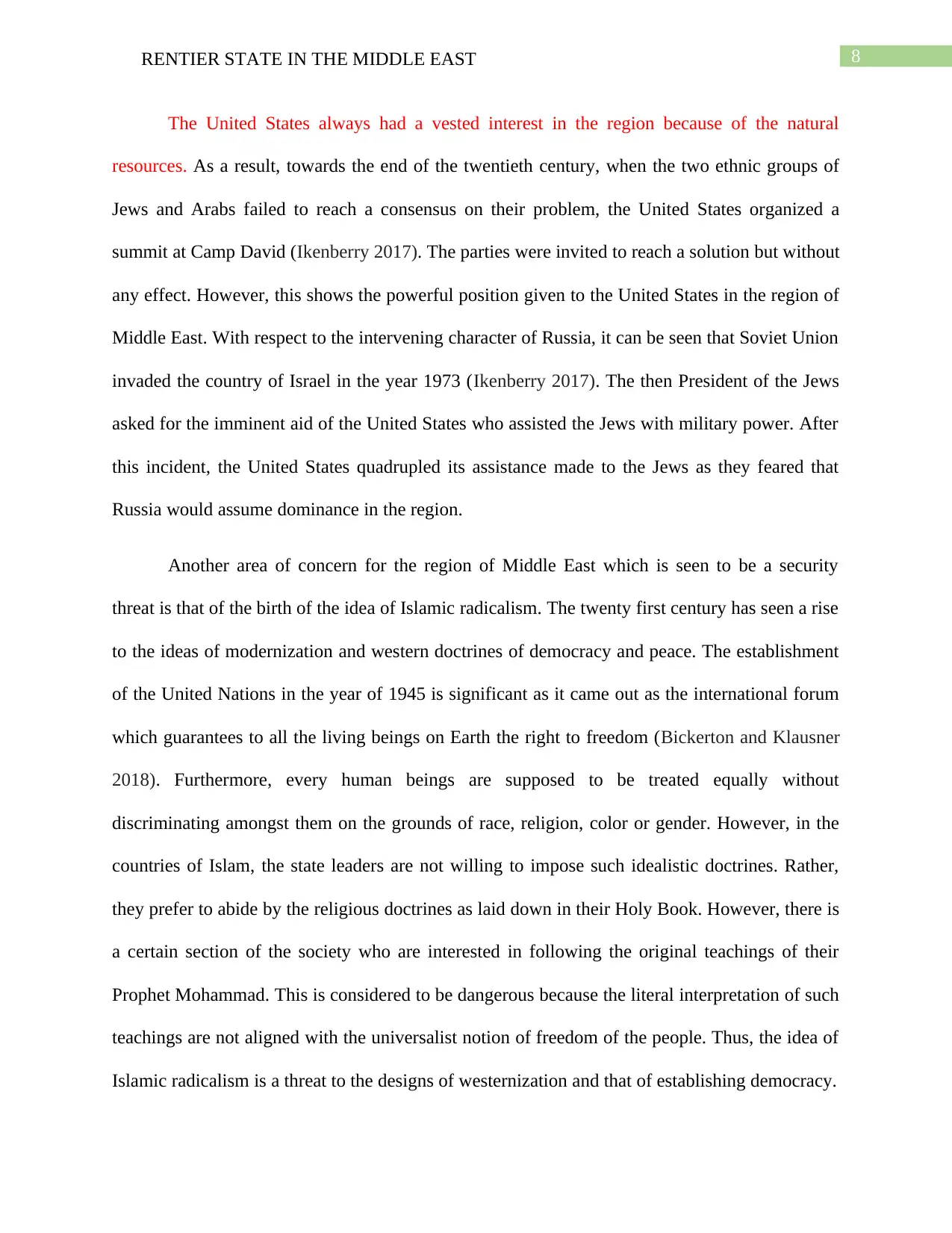
8RENTIER STATE IN THE MIDDLE EAST
The United States always had a vested interest in the region because of the natural
resources. As a result, towards the end of the twentieth century, when the two ethnic groups of
Jews and Arabs failed to reach a consensus on their problem, the United States organized a
summit at Camp David (Ikenberry 2017). The parties were invited to reach a solution but without
any effect. However, this shows the powerful position given to the United States in the region of
Middle East. With respect to the intervening character of Russia, it can be seen that Soviet Union
invaded the country of Israel in the year 1973 (Ikenberry 2017). The then President of the Jews
asked for the imminent aid of the United States who assisted the Jews with military power. After
this incident, the United States quadrupled its assistance made to the Jews as they feared that
Russia would assume dominance in the region.
Another area of concern for the region of Middle East which is seen to be a security
threat is that of the birth of the idea of Islamic radicalism. The twenty first century has seen a rise
to the ideas of modernization and western doctrines of democracy and peace. The establishment
of the United Nations in the year of 1945 is significant as it came out as the international forum
which guarantees to all the living beings on Earth the right to freedom (Bickerton and Klausner
2018). Furthermore, every human beings are supposed to be treated equally without
discriminating amongst them on the grounds of race, religion, color or gender. However, in the
countries of Islam, the state leaders are not willing to impose such idealistic doctrines. Rather,
they prefer to abide by the religious doctrines as laid down in their Holy Book. However, there is
a certain section of the society who are interested in following the original teachings of their
Prophet Mohammad. This is considered to be dangerous because the literal interpretation of such
teachings are not aligned with the universalist notion of freedom of the people. Thus, the idea of
Islamic radicalism is a threat to the designs of westernization and that of establishing democracy.
The United States always had a vested interest in the region because of the natural
resources. As a result, towards the end of the twentieth century, when the two ethnic groups of
Jews and Arabs failed to reach a consensus on their problem, the United States organized a
summit at Camp David (Ikenberry 2017). The parties were invited to reach a solution but without
any effect. However, this shows the powerful position given to the United States in the region of
Middle East. With respect to the intervening character of Russia, it can be seen that Soviet Union
invaded the country of Israel in the year 1973 (Ikenberry 2017). The then President of the Jews
asked for the imminent aid of the United States who assisted the Jews with military power. After
this incident, the United States quadrupled its assistance made to the Jews as they feared that
Russia would assume dominance in the region.
Another area of concern for the region of Middle East which is seen to be a security
threat is that of the birth of the idea of Islamic radicalism. The twenty first century has seen a rise
to the ideas of modernization and western doctrines of democracy and peace. The establishment
of the United Nations in the year of 1945 is significant as it came out as the international forum
which guarantees to all the living beings on Earth the right to freedom (Bickerton and Klausner
2018). Furthermore, every human beings are supposed to be treated equally without
discriminating amongst them on the grounds of race, religion, color or gender. However, in the
countries of Islam, the state leaders are not willing to impose such idealistic doctrines. Rather,
they prefer to abide by the religious doctrines as laid down in their Holy Book. However, there is
a certain section of the society who are interested in following the original teachings of their
Prophet Mohammad. This is considered to be dangerous because the literal interpretation of such
teachings are not aligned with the universalist notion of freedom of the people. Thus, the idea of
Islamic radicalism is a threat to the designs of westernization and that of establishing democracy.
⊘ This is a preview!⊘
Do you want full access?
Subscribe today to unlock all pages.

Trusted by 1+ million students worldwide
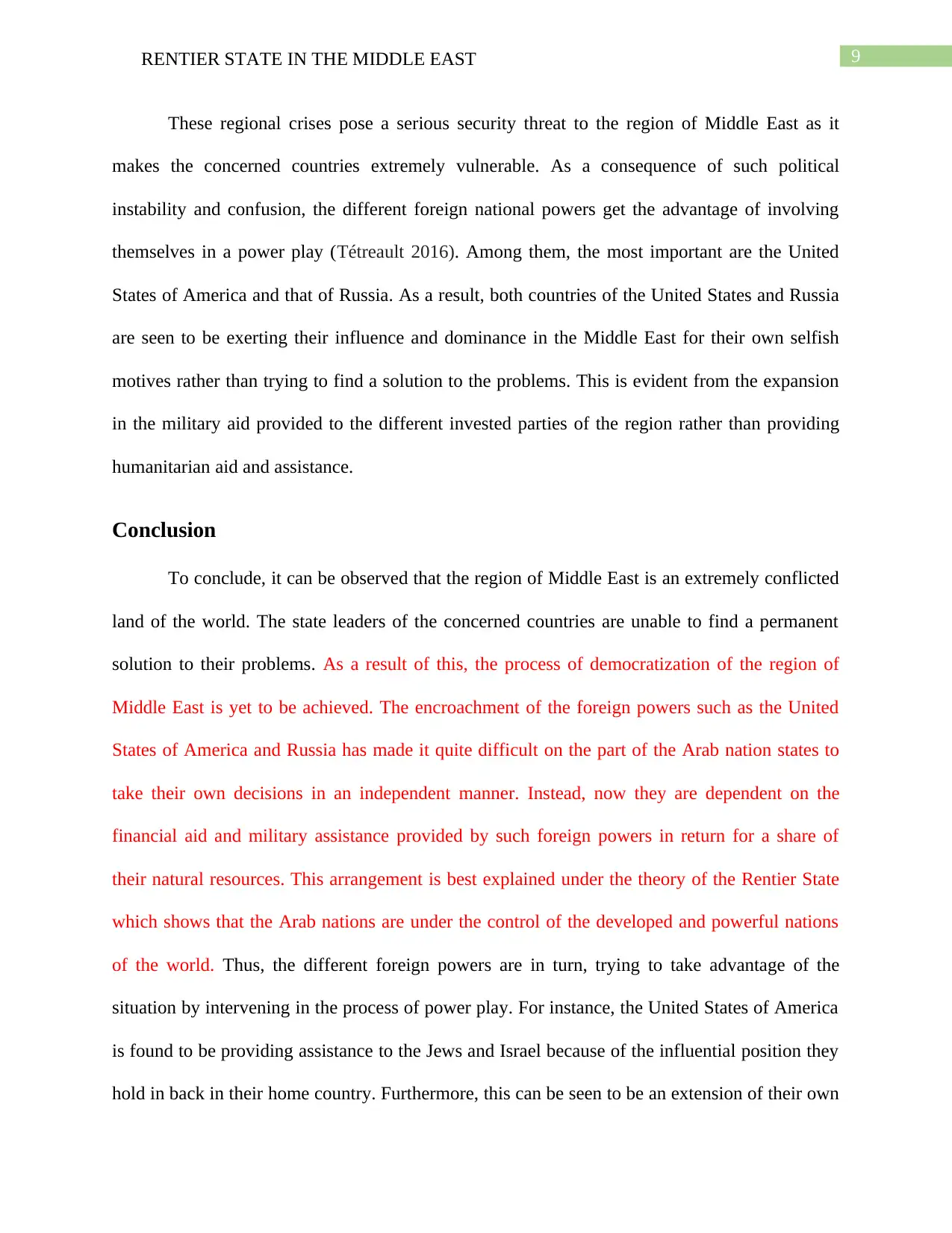
9RENTIER STATE IN THE MIDDLE EAST
These regional crises pose a serious security threat to the region of Middle East as it
makes the concerned countries extremely vulnerable. As a consequence of such political
instability and confusion, the different foreign national powers get the advantage of involving
themselves in a power play (Tétreault 2016). Among them, the most important are the United
States of America and that of Russia. As a result, both countries of the United States and Russia
are seen to be exerting their influence and dominance in the Middle East for their own selfish
motives rather than trying to find a solution to the problems. This is evident from the expansion
in the military aid provided to the different invested parties of the region rather than providing
humanitarian aid and assistance.
Conclusion
To conclude, it can be observed that the region of Middle East is an extremely conflicted
land of the world. The state leaders of the concerned countries are unable to find a permanent
solution to their problems. As a result of this, the process of democratization of the region of
Middle East is yet to be achieved. The encroachment of the foreign powers such as the United
States of America and Russia has made it quite difficult on the part of the Arab nation states to
take their own decisions in an independent manner. Instead, now they are dependent on the
financial aid and military assistance provided by such foreign powers in return for a share of
their natural resources. This arrangement is best explained under the theory of the Rentier State
which shows that the Arab nations are under the control of the developed and powerful nations
of the world. Thus, the different foreign powers are in turn, trying to take advantage of the
situation by intervening in the process of power play. For instance, the United States of America
is found to be providing assistance to the Jews and Israel because of the influential position they
hold in back in their home country. Furthermore, this can be seen to be an extension of their own
These regional crises pose a serious security threat to the region of Middle East as it
makes the concerned countries extremely vulnerable. As a consequence of such political
instability and confusion, the different foreign national powers get the advantage of involving
themselves in a power play (Tétreault 2016). Among them, the most important are the United
States of America and that of Russia. As a result, both countries of the United States and Russia
are seen to be exerting their influence and dominance in the Middle East for their own selfish
motives rather than trying to find a solution to the problems. This is evident from the expansion
in the military aid provided to the different invested parties of the region rather than providing
humanitarian aid and assistance.
Conclusion
To conclude, it can be observed that the region of Middle East is an extremely conflicted
land of the world. The state leaders of the concerned countries are unable to find a permanent
solution to their problems. As a result of this, the process of democratization of the region of
Middle East is yet to be achieved. The encroachment of the foreign powers such as the United
States of America and Russia has made it quite difficult on the part of the Arab nation states to
take their own decisions in an independent manner. Instead, now they are dependent on the
financial aid and military assistance provided by such foreign powers in return for a share of
their natural resources. This arrangement is best explained under the theory of the Rentier State
which shows that the Arab nations are under the control of the developed and powerful nations
of the world. Thus, the different foreign powers are in turn, trying to take advantage of the
situation by intervening in the process of power play. For instance, the United States of America
is found to be providing assistance to the Jews and Israel because of the influential position they
hold in back in their home country. Furthermore, this can be seen to be an extension of their own
Paraphrase This Document
Need a fresh take? Get an instant paraphrase of this document with our AI Paraphraser
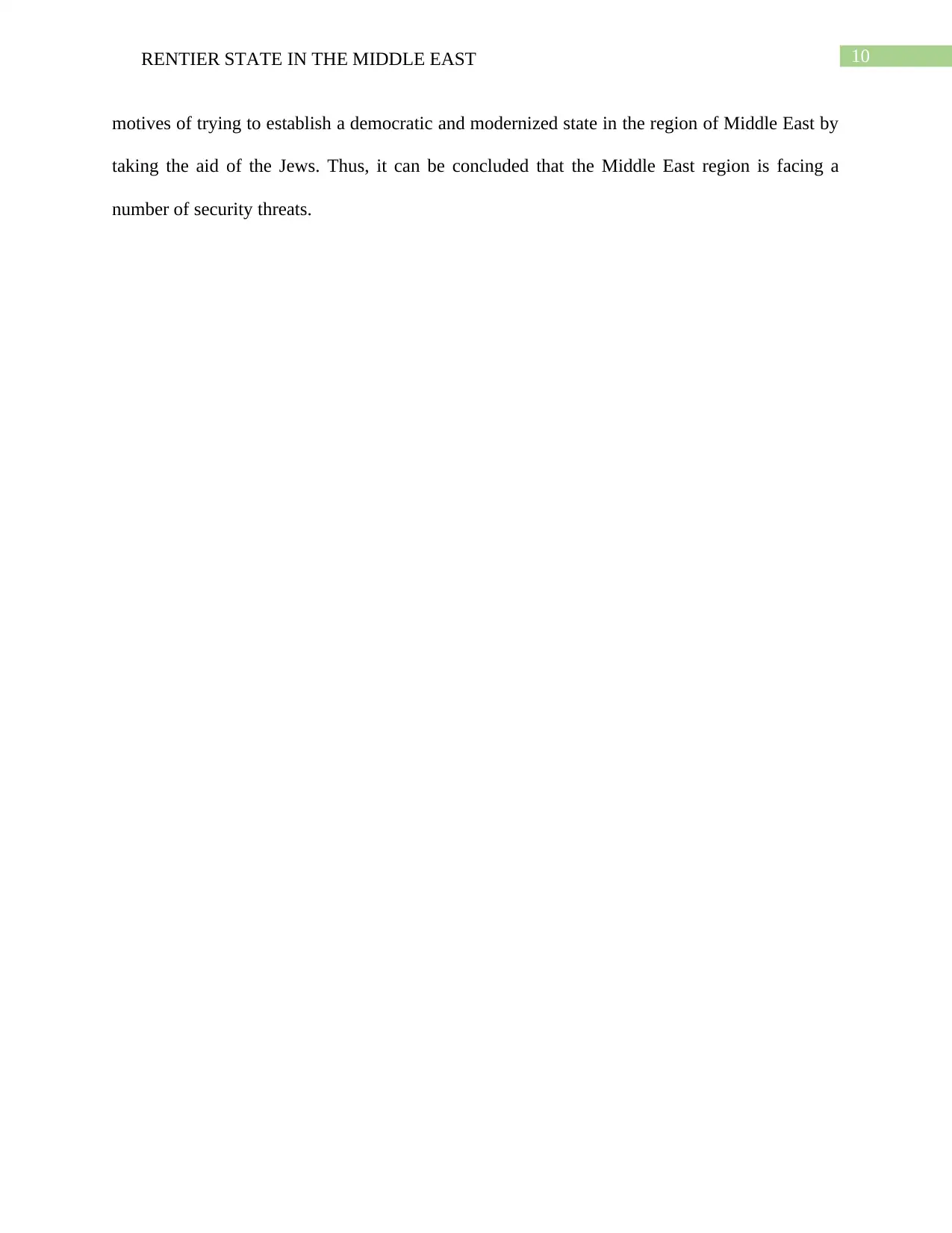
10RENTIER STATE IN THE MIDDLE EAST
motives of trying to establish a democratic and modernized state in the region of Middle East by
taking the aid of the Jews. Thus, it can be concluded that the Middle East region is facing a
number of security threats.
motives of trying to establish a democratic and modernized state in the region of Middle East by
taking the aid of the Jews. Thus, it can be concluded that the Middle East region is facing a
number of security threats.
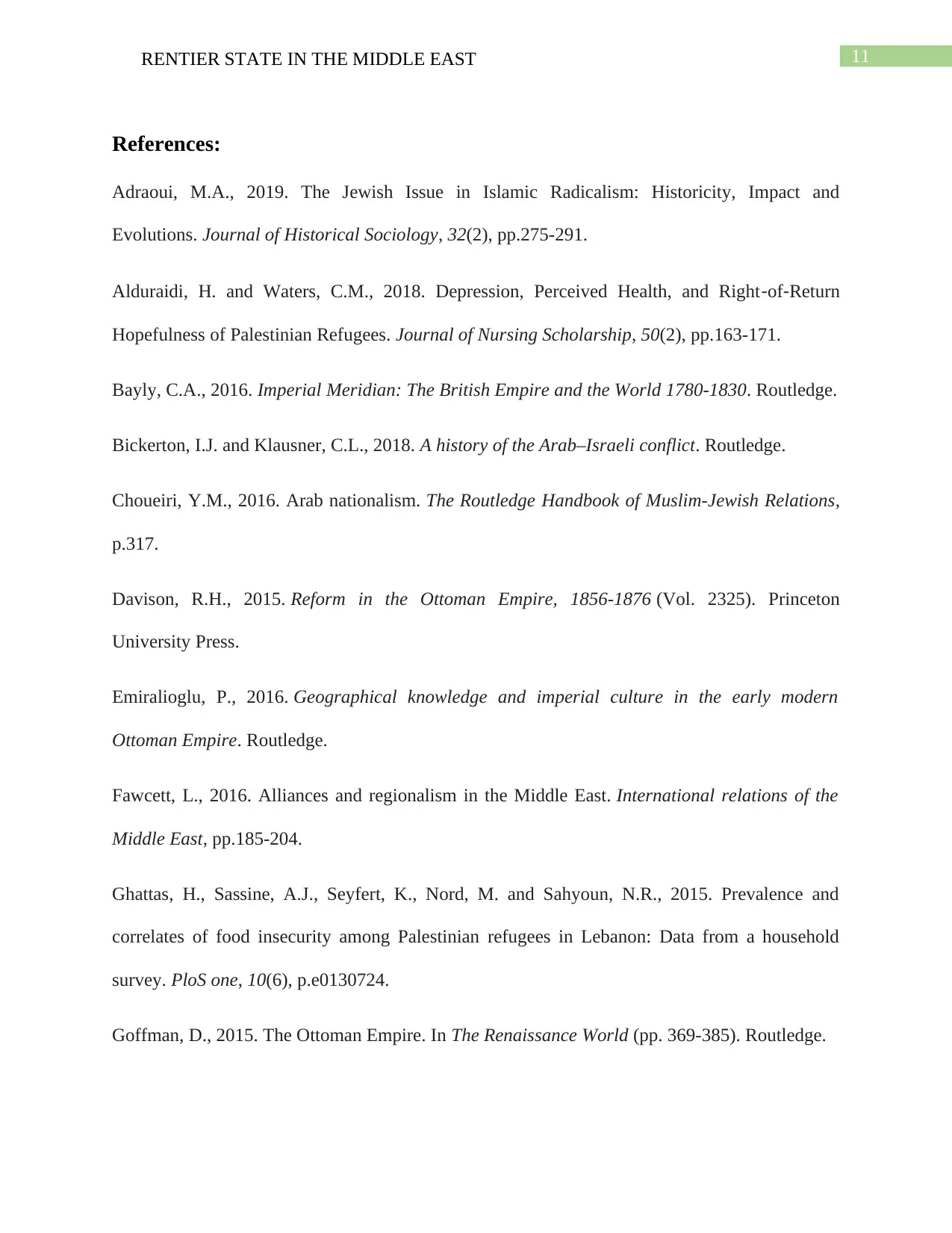
11RENTIER STATE IN THE MIDDLE EAST
References:
Adraoui, M.A., 2019. The Jewish Issue in Islamic Radicalism: Historicity, Impact and
Evolutions. Journal of Historical Sociology, 32(2), pp.275-291.
Alduraidi, H. and Waters, C.M., 2018. Depression, Perceived Health, and Right‐of‐Return
Hopefulness of Palestinian Refugees. Journal of Nursing Scholarship, 50(2), pp.163-171.
Bayly, C.A., 2016. Imperial Meridian: The British Empire and the World 1780-1830. Routledge.
Bickerton, I.J. and Klausner, C.L., 2018. A history of the Arab–Israeli conflict. Routledge.
Choueiri, Y.M., 2016. Arab nationalism. The Routledge Handbook of Muslim-Jewish Relations,
p.317.
Davison, R.H., 2015. Reform in the Ottoman Empire, 1856-1876 (Vol. 2325). Princeton
University Press.
Emiralioglu, P., 2016. Geographical knowledge and imperial culture in the early modern
Ottoman Empire. Routledge.
Fawcett, L., 2016. Alliances and regionalism in the Middle East. International relations of the
Middle East, pp.185-204.
Ghattas, H., Sassine, A.J., Seyfert, K., Nord, M. and Sahyoun, N.R., 2015. Prevalence and
correlates of food insecurity among Palestinian refugees in Lebanon: Data from a household
survey. PloS one, 10(6), p.e0130724.
Goffman, D., 2015. The Ottoman Empire. In The Renaissance World (pp. 369-385). Routledge.
References:
Adraoui, M.A., 2019. The Jewish Issue in Islamic Radicalism: Historicity, Impact and
Evolutions. Journal of Historical Sociology, 32(2), pp.275-291.
Alduraidi, H. and Waters, C.M., 2018. Depression, Perceived Health, and Right‐of‐Return
Hopefulness of Palestinian Refugees. Journal of Nursing Scholarship, 50(2), pp.163-171.
Bayly, C.A., 2016. Imperial Meridian: The British Empire and the World 1780-1830. Routledge.
Bickerton, I.J. and Klausner, C.L., 2018. A history of the Arab–Israeli conflict. Routledge.
Choueiri, Y.M., 2016. Arab nationalism. The Routledge Handbook of Muslim-Jewish Relations,
p.317.
Davison, R.H., 2015. Reform in the Ottoman Empire, 1856-1876 (Vol. 2325). Princeton
University Press.
Emiralioglu, P., 2016. Geographical knowledge and imperial culture in the early modern
Ottoman Empire. Routledge.
Fawcett, L., 2016. Alliances and regionalism in the Middle East. International relations of the
Middle East, pp.185-204.
Ghattas, H., Sassine, A.J., Seyfert, K., Nord, M. and Sahyoun, N.R., 2015. Prevalence and
correlates of food insecurity among Palestinian refugees in Lebanon: Data from a household
survey. PloS one, 10(6), p.e0130724.
Goffman, D., 2015. The Ottoman Empire. In The Renaissance World (pp. 369-385). Routledge.
⊘ This is a preview!⊘
Do you want full access?
Subscribe today to unlock all pages.

Trusted by 1+ million students worldwide
1 out of 14
Related Documents
Your All-in-One AI-Powered Toolkit for Academic Success.
+13062052269
info@desklib.com
Available 24*7 on WhatsApp / Email
![[object Object]](/_next/static/media/star-bottom.7253800d.svg)
Unlock your academic potential
Copyright © 2020–2025 A2Z Services. All Rights Reserved. Developed and managed by ZUCOL.





